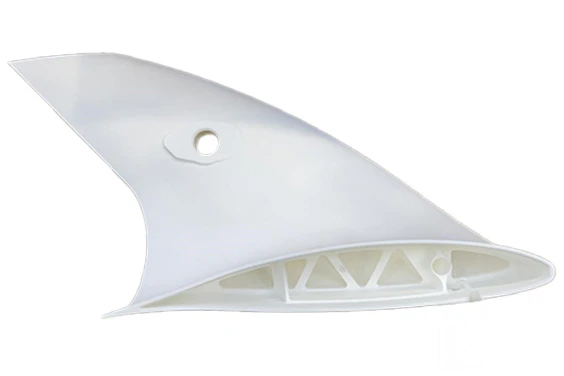The 2023 Paris Air Show saw GKN take yet another major step forward, with the third iteration of its directed energy deposition (DED) 3D printer. At the event, the British company’s aviation division, GKN Aerospace, announced the commissioning Cell 3, the latest of its DED machines for its new Global Technology Center in Texas. Additionally, the firm signed an agreement with AM solutions and services provider Materialise (Nasdaq: MTLS) dedicated to the research, design and production of polymer 3D printed parts for aerospace.
GKN’s Cell 3 DED 3D Printer
As a part of a $17.8 million, five-year project with Oak Ridge National Laboratory (ORNL) that began in 2017, GKN Aerospace developed a laser metal deposition with wire (LMD-w) technology for the production of large-scale titanium aircraft parts. While the original Cell 1 system is operating at ORNL, where it has been used to make engines and aerospace components, Cell 2 was commissioned at ORNL in 2019.

The Cell 3 DED 3D printer from GKN Aerospace.
This latter machine featured 8-axis motion, a 20kW laser, and the ability to perform two-sided deposition onto a substrate up to 1.32m x .81m in size. This resulted in a 2.5 meter titanium structure unveiled by GKN in 2022. The new Cell 3 is significantly larger, capable of printing onto a substrate of up to 5.6m x 2.5m. While it maintains the 20KW laser, it has 10 axes of motion within its 12,000 cubic meters of inert printing environment.
“Cell 3 will create opportunities to deliver a whole new level of additively manufactured titanium components to sizes needed for safety-critical air and space structures. We are very excited to bring this new equipment to our current line of product development LMD-w cells in the US. This will accelerate the introduction of our technology into production while helping to support the US supply chain and reducing reliance on foreign-sourced materials,” said Shawn Black, GKN Aerospace’s President of Defence. “LMD-w is a game-changer and a more sustainable alternative for production in a wide range of civil and defence structures. The method has shown its proficiencies in producing components faster and with significantly reduced lead times. We also look forward to expanding this technology’s role in sustainability and efficiencies through additional collaborations with customers and universities.”
Materialise Partnership
Materialise has supplied polymer parts to GKN since 2015, including 3D printed wingtips for Eviation’s Alice, said to be “the world’s largest all-electric aircraft,” which first took off in 2022. The new agreement will see the partners speed up the certification of AM for 3D printing functional and flight-critical parts. Specifically, the companies will focus on electric vertical takeoff and landing (eVTOL) aircraft.

Eviation’s Alice with 3D printed wing tips.
“This powerful alliance aims to leverage our combined expertise and the exceptional benefits of 3D printing to push the boundaries of innovation in the aeronautics industry”, says Jurgen Laudus, Vice President of Materialise Manufacturing. “Together, we aim to drive technological advancements, respond more effectively to customer requirements, and shape the future of aerospace manufacturing.”
Russ Brigham, Programme Director at GKN Aerospace said: “Materialise is a valued AM supplier for GKN Aerospace and partnering with them on this ground-breaking technology has been a success for both companies. AM is out there and flying on aircraft around the world today and will be critical to achieve a more sustainable future of flight ahead.”

Eviation’s 3D printed wing tips.
Supply Chain Resilience and Decarbonization
As we’ve noted regularly on 3DPrint.com, the name of the game for AM going forward is supply chain resilience and decarbonization. In this case, the Cell 3 represents the former and the Materialise partnership the latter. As a technique for producing parts quickly and closest to their point of use, 3D printing has become the go-to method for avoiding supply chain disruptions, hence the installation of the Cell 3 at a new facility in the U.S. for GKN’s American customers. Meanwhile, AM is also able to reduce the weight of vehicles, a key element for enabling electric motors to power heavy objects like aircraft.
The most mysterious trend that is also developing is the eVTOL sector, whose exact market is unclear. Of course, nearly everyone would want to take a ride in such a vehicle, but the need to hop from place to place seems less pressing than the need to decarbonize human industry. As the eVTOL sector matures, just how viable it is and who is chasing it will become more obvious. For now, my personal guess is that these are essentially escape pods for the wealthy as climate catastrophe and resource scarcity unfolds.
Subscribe to Our Email Newsletter
Stay up-to-date on all the latest news from the 3D printing industry and receive information and offers from third party vendors.
You May Also Like
Further Understanding of 3D Printing Design at ADDITIV Design World
ADDITIV is back once again! This time, the virtual platform for additive manufacturing will be holding the first-ever edition of ADDITIV Design World on May 23rd from 9:00 AM –...
3D Printer Maker EVO-tech Reborn as NEVO3D — Once More With Feeling
EVO-tech was a 3D printing service and original equipment manufacturer established in 2013 and based in Schörfling am Attersee, Austria. The company produced high-quality material extrusion systems featuring linear bearings,...
3D Systems Brings 3D Printed PEEK Cranial Implant to the U.S. with FDA Clearance
For more than 10 years, 3D Systems (NYSE:DDD) has worked hand-in-hand with surgeons to plan over 150,000 patient-specific cases, and develop more than two million instruments and implants from its...
CDFAM Returns to Berlin for Second Annual Symposium
The second CDFAM Computational Design Symposium is scheduled for May 7-8, 2024, in Berlin, and will convene leading experts in computational design across all scales. Building upon the first event...































